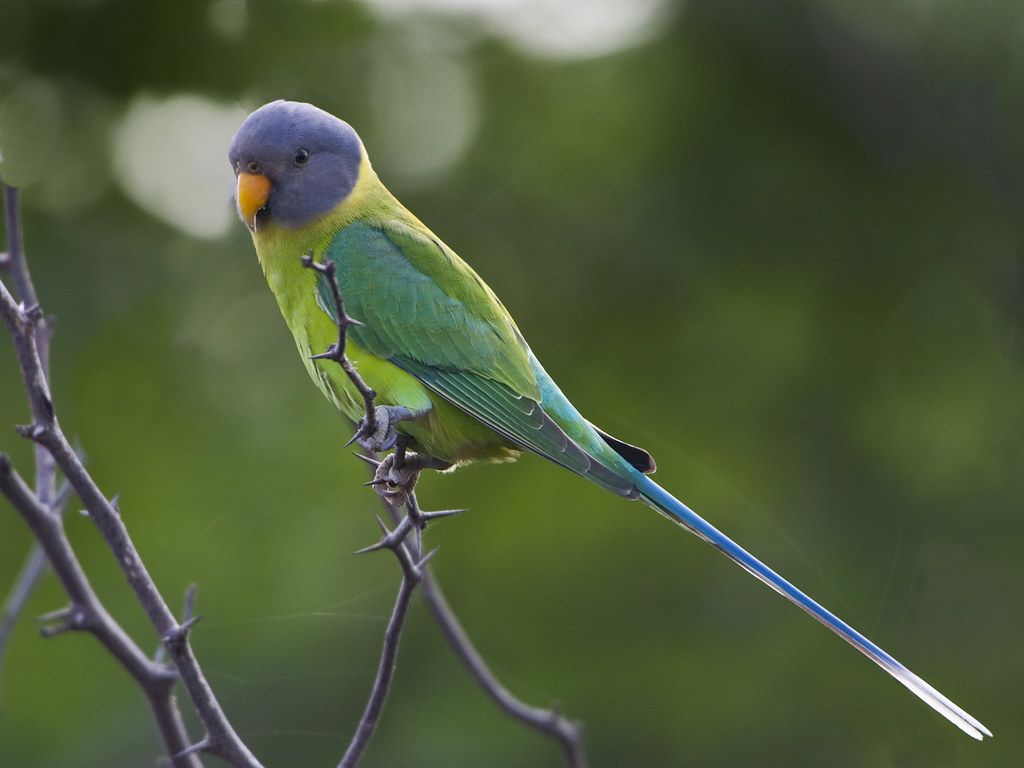Table of Contents
All About Plum-Headed Parakeets
Meet the Plum-Headed Parakeet
Say hello to the plum-headed parakeet, a chatterbox with a flair for fashion. Native to the Indian subcontinent, these little guys are like the A-listers of the parrot world. Their colorful feathers and bubbly personalities make them impossible to ignore.
Roughly the size of a standard ruler, these parakeets measure about 13 to 14 inches, tail feathers included (source). You’ll mostly spot them in a vibrant green, but their head colors are where the magic happens, with males and females offering a splash of variety.
Their Dazzling Looks
The head color game is strong with these birds. Males rock a bright red head that softens into a purple-blue fade on top and down the cheeks. Meanwhile, females pull off a more low-key look with a blue-gray head (source). Both have red shoulder patches, a signature look that sets them apart.
Check out the table for a quick glance:
| Gender | Head Color | Shoulder Patch | Tail Color & Tip |
|---|---|---|---|
| Male | Red to purple-blue | Red | Blue with white tips |
| Female | Blue-gray | Red | Blue with white tips |
Take a closer look at their neighbors, like the blossom-headed parakeet. These birds flaunt a maroon shoulder patch and a shorter tail with a yellow tip, making the plum-headed parakeet’s two-tone blue and white tail even more unique (Wikipedia).
Sporting such bright hues, plum-headed parakeets naturally draw attention, whether they’re fluttering in the wild or perched at home. They’re a big hit among parrot fans, and trust us, they know how to work a crowd.
Different Parakeets to Explore
If you’re smitten by these flashy birds, you’ll probably want to meet their cousins too. Check out the alexandrine parakeet for a chunkier look, the derbyan parakeet for a more distinguished color play, or the red-rumped parrot with its own flair. There’s a whole flock of fascinating species out there, each with its own personality and pizzazz.
So, whether you’re a parrot pro or just poking around, the plum-headed parakeet is bound to brighten your day and maybe even your backyard.
Home Sweet Home: Plum-Headed Parakeets
Ever wonder what it’s like to be a plum-headed parakeet? Let’s sneak a peek into their world – where they live, what they munch on, and how they go about starting a family.
Where They Hang Out
Plum-headed parakeets are like seasoned travelers of the Indian Subcontinent. You’ll find them flying from the Himalayan foothills to the tropical vibes of Sri Lanka, and they even hang out in Nepal and Bhutan (That Bird Blog). These birds are all about lush forests and open woodlands, but they won’t say no to a well-kept garden in the city. Dry western parts of India? Not their thing.
| Place | Are They There? |
|---|---|
| Himalayan Foothills | Yep |
| Western Pakistan to Sri Lanka | Yep |
| Nepal and Bhutan | Yep |
| Western India | No way |
What’s on the Menu?
Plum-headed parakeets are fruit fanatics. They love their fruits and berries, and they add a variety of nuts to their menu. Occasionally, you might catch them nibbling on flower petals or sipping nectar (Wildlife Vagabond). These guys really know how to keep their diet interesting.
| Food | Examples |
|---|---|
| Fruits | Tropical treats |
| Berries | Wild finds |
| Nuts | Tree goodies |
| Blossoms | Flower power |
| Nectar | Sweet sips |
If you’ve got these parrots as pets, keep ’em happy with a mix of fruit and some nuts now and then.
Starting the Family
Come December to April, plum-headed parakeets get busy. In Sri Lanka, though, they might prefer the warmer months of July and August. Their nests? Tree holes make the perfect nurseries where mom lays around 4 to 6 white eggs. The wait for the eggs to hatch is about 20-23 days, and after that, the babies – who are born helpless, blind, and featherless – rely fully on their parents until they grow feathers and learn to fly, around 6-7 weeks later.
| Breeding Time | Egg Count |
|---|---|
| December to April | 4-6 eggs |
| July to August (Sri Lanka) | 4-6 eggs |
Understanding their habitat and behavior not only brings us closer to these beautiful birds but also helps in appreciating their vibrant lives. Want to learn more? Check out our pages on the ring-necked parakeet, alexandrine parakeet, and other parrot species.
Plum-Headed Parakeets in Captivity
Let’s chat about taking care of our delightful plum-headed parakeets. We’ll cover their lifespan, care tips, training, social interaction, and their unique looks.
Lifespan and Care Tips
In captivity, plum-headed parakeets usually live around 10 to 15 years, but great care can extend that. A solid diet, a safe home, and regular vet visits are crucial.
| What Affects Lifespan | Details |
|---|---|
| Average Lifespan | 10 – 15 years |
| Diet | Mix of seeds, fruits, veggies |
| Environment | Spacious cage with toys and perches |
| Healthcare | Regular vet visits |
Give them a balanced diet of seeds, fruits, and veggies. Apples, bananas, and berries are excellent options. Regular vet visits catch any health issues early. Their home should be roomy, filled with toys and perches to keep them busy and happy.
Training and Social Interaction
These social butterflies love interaction. Training them requires patience and consistency. Use treats and praise for positive reinforcement to teach them new tricks. Spending daily time with them builds trust and companionship.
Keeping them engaged is important too. They love playful activities and learning new tricks. Toys designed for parrots and quality time reduce stress and boost their overall happiness.
| Training Tips | Details |
|---|---|
| Positive Reinforcement | Treats work wonders |
| Daily Interaction | Spend time every day |
| Toys and Activities | Mix up the toys to keep them entertained |
Common Mutations and Variations
Plum-headed parakeets come in various colors, making each one special. Common mutations include different shades of blue, yellow, and white. These are results of selective breeding and add diversity to our aviary.
Some notable mutations include:
- Blue Mutation: Gorgeous blue feathers replace the usual green.
- Yellow Mutation: Vibrant yellow feathers, sometimes with a touch of green.
- Albino Mutation: Pure white feathers with red eyes, a combo of blue and yellow mutations.
Knowing these mutations helps us see the beauty in their diversity.
By giving top-notch care, proper training, and lots of interaction, our plum-headed parakeets can lead a joyful and healthy life. Check out more about different parrot species to enrich your experience as a parrot parent.
Conservation Status and Threats
IUCN Red List Classification
Good news for our feathered friends: the Plum-headed Parakeet is listed as “Least Concern” (LC) on the IUCN Red List. This means they’re pretty much owning their turf out in the wild. But hold on, even though they’ve got a decent population spread, they’re not out of the woods yet. Habitat loss is chipping away at their numbers (Animalia).
| Conservation Status | Classification |
|---|---|
| IUCN Red List | Least Concern (LC) |
Challenges and Threats
So, what’s bugging the Plum-headed Parakeet?
The main headache: habitat loss. Humans keeping expanding their territory, chopping down forests, and building stuff. This bad news for our parakeets, making it tough for them to find food, cozy nests, and places to breed.
Then there’s the pet trade. These birds aren’t as high up on the black market list as other parrots, but they still get nabbed for a quick buck. Snatching them from the wild for pets can seriously mess with their numbers, especially when breeding birds are taken.
If you love these colorful critters as much as we do, it’s time to step up. Safeguard their homes, support ethical practices, and be a responsible pet owner. Spread the word and let’s make sure these beauties thrive.
| Threat | Impact |
|---|---|
| Habitat Loss | High |
| Pet Trade | Moderate |
Curious about other parrots? Check out our pages on the Amazon Parrot, Macaw, and Eclectus Parrot for more info.
Cool Facts About Plum-Headed Parakeets
Let’s chat about the delightful plum-headed parakeet. This feathered gem is full of surprises that make it a standout among birds.
Bird Gossip and Mimicry
These parakeets are the chatterboxes of the bird world. They love to socialize and make a racket with their squawks and tweets (Animalia). If you keep one as a pet, get ready for a show! They can mimic all sorts of sounds: from electronic beeps and whistling tunes to actual human speech (Wikipedia).
Color Explosion
The males are like little flying rainbows, flaunting a red and purple head and a bold maroon shoulder patch. Female plum-headed parakeets rock a chic blue-grey head. Both sexes sport a vibrant green body and a tail dipped in blue (Wildlife Vagabond).
These parakeets aren’t picky eaters either. They munch on grains, fruits, flower petals, and even sneak into farms and orchards for a snack. They’re adaptable feeders, moving around to find whatever’s in season.
Home Sweet Habitat
Plum-headed parakeets call the Indian subcontinent their home, stretching from the lush Himalayan foothills to the beautiful landscapes of Sri Lanka. They give the dry western parts of India a miss (Animalia). Whether it’s forests, woodlands, or city gardens, they fit right in.
These birds are early risers and active during the day. Their social nature is evident in their communal roosting habits, adding to the daily buzz of fruit-hunting and flower-feasting.
| What They’re Like | Details |
|---|---|
| Size | 33 – 36 cm (13 – 14 in) |
| Where They Live | Forests, woodlands, city gardens |
| What They Eat | Grains, fruits, flowers |
| Sound Skills | Mimic sounds, beeps, whistles |
| Where They’re From | India, Himalayas to Sri Lanka |
| Day or Night | Active during the day, sleep in groups |
These plum-headed parakeets sure know how to keep things interesting. Bird fans and pet owners alike can’t help but be charmed. Dive into more feathered fun by exploring our posts on other parrot species like the budgerigar and the african grey parrot. They’re packed with cool facts and tips!

